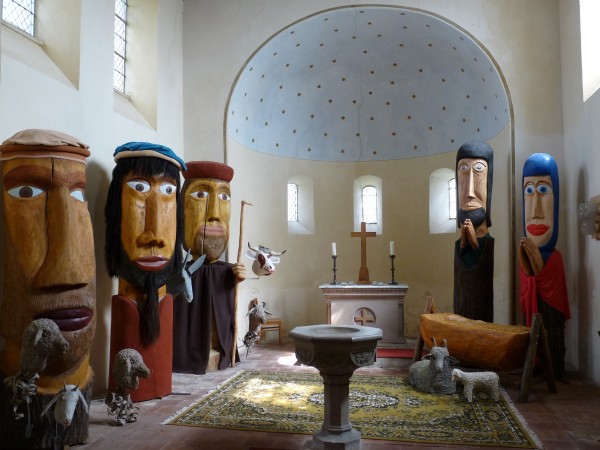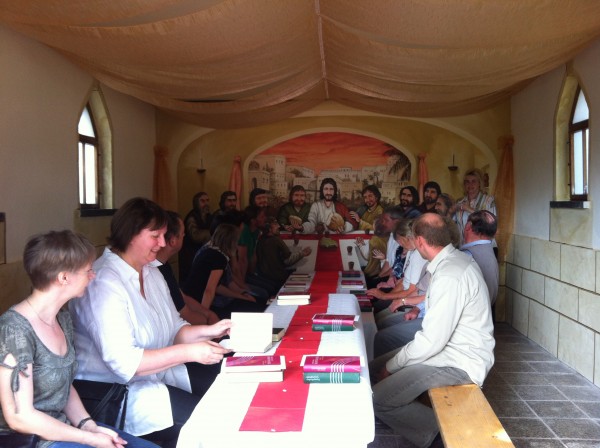Erhaltung und Nutzung des Religiösen Erbes im ländlichen Raum in Europa
FRH-Tagung, 29.10. – 01.11. 2014, Halle (Saale), Deutschland
Summary
Community development and volunteering in a rural parish in Sachsen-Anhalt
by Sonja Hahn – Art Historian, Chairwoman of „Förderkreis Entschlossene Kirchen e.V.“, Zerbst
„Sometimes there has to be a fall first before something new can flourish.“
(Parish priest Thomas Meyer)

Explaining the very special concept of preserving our religious heritage I have to introduce our small parish community at first. The „Evangelische Weinberggemeinde Garitz“ is a parish of the protestant church of Anhalt, which is the smallest established protestant church in Germany, located in the state of Sachsen-Anhalt. Our parish belongs to the church district of Zerbst. Zerbst by the way is now a small town in the countryside but by the time of the reformation it was one of the bigger cities in the centre of Germany and among the first cities that adopted the reformation. Martin Luther often visited Zerbst and preached in the city’s Augustinian monastery.
The church district nowadays includes 61 very small villages with their own village churches. All of them are classified as historical monuments. Not only that the villages are very small – many of them have less than 100 inhabitants – the great majority of the population now is atheistic. To give an example: Our parish consists of five villages with four village churches: one Village (Garitz) has 250 inhabitants, the others have less than 100. Only one third of the population is Christian. And this is not even representative for the situation in the whole state.
In the state of Sachsen-Anhalt only 17,4 percent of the total population are Christians. Christians of both confessions – protestants and catholics – here in Sachsen-Anhalt form a constantly declining minority. Of course the secularization is a late result of the anti-clerical policies of the GDR, but it is an ongoing process for almost several decades now. And what makes the problem worse is the fact that this is a self-reinforcing process, unless something is done about it. We are now facing the third generation of people having left the church. The first generation was still socialized in a Christian manner. But not the following generations. There was nobody to tell them the basics about the faith, the cult and even the Christian culture. So the young generation itself is not anti-clerical, but simply not informed about religion and Christianity.
Few Christians attended church regularly. So it made no sense to hold regular services in each village only for five or fewer churchgoers. Moreover, in our case, there is only one priest responsible for 10 widely scattered villages and half of the city’s district of Zerbst. Under these circumstances it was not possible to obtain a normal church life up. Not to mention the overwhelming problem for nearly all parishes elsewhere in Sachsen-Anhalt: the lack of money. Therefore new ideas were requested as a matter of urgency. Fortunately, we had a very open-minded priest and a young parish council. We understand that it is our chance to live in the countryside in villages where mutual aid still is a matter of course. We wanted to take this opportunity.
Together we decided not to close down and to decommission our village churches. We considered these old churches as a treasure that has been entrusted to us. In our secularised society here in Sachsen-Anhalt often only the existence of the church buildings itself reminds of the cultural heritage of Christianity. So we opted instead for the use of village churches deliberately as churches, even though we do not really need all for our regular services. We decided to open the churches 24 hours a day throughout the year for all villagers and visitors, whether they are Christians or not. And we asked our fellow villagers for help to preserve the old church buildings, whenever it was needed. Doing so we explicitly wanted to address those who are not members of our church and include them. The message was understood. Many of them now regard the village churches as their heritage, too, and feel responsible for it. Young people of the volunteer fire department, for instance, who never before had contact with the church as an institution now regularly come to say prayers in „their“ village churches and help us to organize parish festivals.

Of course it was impossible to perform the necessary basic renovation of the old church buildings only by neighbourly help. The reconstruction and restoration of the churches was done with the help of government subsidies. But the condition to this aid was a viable concept for the maintenance of the buildings. In order to fulfil this requirement the parishes of our church district agreed in 2005 to establish an own foundation for this purpose under the patronage of the „Deutsche Stiftung Denkmalschutz“ (German National Fund for the Protection of Monuments) This new foundation – „Stiftung Entschlossene Kirchen“ (the german Word „entschlossen“ has two different meanings: on the one hand it means „determined“ and on the other “unlocked“, so this name should signal our church is determined and active and this specific village church is unlocked and open to the public) manages the funds paid by the parishes (amounts of 3000 € for each village church) to held equity in stock for future renovations. In addition, a non-profit organization was founded in 2008 – the „Förderkreis Entschlossene Kirchen“ (support group). This organization is responsible for public relations: it hosts concerts, lectures and festivals in the village churches and it offers training for volunteer tourist guides. This indeed, is a very successful activity. The increasing interest of tourists to visit our village churches also raises the curiosity of our non-Christian neighbours. The „Förderkreis“-organization enhanced this interest by opening a little permanent exhibition in 2010: the „Dorfkirchen-Museum“ (village church museum) in Garitz.
The radical opening of our churches and the activities of the „Förderkreis“ (supporters group) were only first steps in our conception. Right from the beginning we knew that it would not be enough to open the churches most of the time only for quiet contemplation. So we were looking for a way to let the old village churches „talk“. The old imagery of churches is indeed no longer understood by those who have no prior knowledge about Christianity. In order to get this alienated generation interested again we would have to provide basic information about church and Christianity in a contemporary and yet unobtrusive manner. This was for sure.
It was our parish priest, Thomas Meyer, who developed the brilliant idea of „Themen-Kirchen“ – themed churches. The largest out of the four village churches was used regularly by our unified parish for the Christmas service. For the rest of the year there were only few occasions for to use the church appropriate. So it was called the „Christmas Church“ even before it was officially named as „Weihnachtskirche“ (Christmas Church) in 2009. A local artist carved in the following years on behalf of the parish a giant Christmas crib from linden wood trunks that remains all the year in the church. The “Weihnachtskirche“ with „Germany’s largest Nativity Scene“ in the small village of Polenzko became famous nationwide. It now attracts visitors from everywhere: travel groups, school classes, choirs to sing Advent.
The keystone of our concept to preserve the religious heritage in our region is the „Easter Church“ in the village of Trüben. As complementary to the themed church in Polenzko the „Easter church“ is a more ambitious project: up to the year 2017 – the five hundredth anniversary of the Reformation – a permanent exhibition shaped after the principles of experiential education will be erected around the small medieval church. The Passion Path of Christ should be made understandable especially to young visitors or those without any prior knowledge. A scenery consisting of images and objects will illustrate its individual stations from Jesus entry into Jerusalem on Palm Sunday up to the discovery of the empty tomb on Easter Sunday. Almost one third of the planned scope is already completed. For example, a former cemetery hall was remodeled. It is now a little chapel with a mural of the Last Supper. Table and benches „grow“ to some extent out of the picture into reality. So visitors can take place at the same table with Jesus. For the full completion of the project the „Weinberg-Gemeinde“ and the „Förderkreis“ rely on generous donations and active participation of the villagers.
Finally, the last-mentioned aspect is worth to be highlighted again: Our concept of open churches, cultural events and themed churches would never succeed without the active help of many neighbours, whether they are Christians or not-yet-Christians: strong young men who lend a hand, women who prepare food, brew coffee and bake cake for festivities, young people who make music. We asked them for help and they helped. Again, Christians or not-Christians, by participating, they all develop a certain respect for the religious heritage of their region. And so do their families and friends. We are often asked if anything was stolen or damaged in our unlocked churches. The answer is: We have not even once had a bad experience.
We, the Christians, are still a minority in our rural area. But we are a well-respected one. More and more young people accept our invitations with pleasure. Two decades ago, most residents had never set foot in the church in their village. Today there are very few who never had done it. Even the lone visit to the church, the encounter with the silence, gives people new hope. Some time ago, an anonymous entry found in the guestbook of the village church of Garitz: „Get me! Life here is not worth living, it’s a journey back and forth. I wish redemption.“ Several months later a new entry in the same handwriting: „I have arrived and I’m thankful to be here. I love life and my family in good and in bad times. Protect the people who stand at my side!“ Here, apparently, someone had spoken quietly with God. And he or she had received a response. Is there a better reason to open our churches for all people?





Follow us: